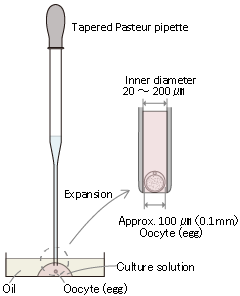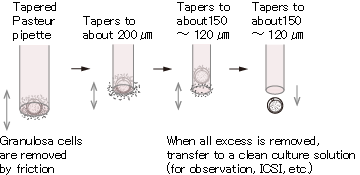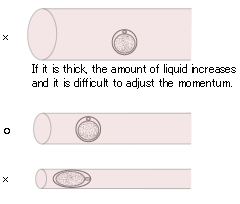
There are many items that embryologists need to handle oocytes, but among them, the Pasteur pipette one of the most critical at various phases.
It is used for moving oocytes, by drawing up oocytes together with the culture solution and adding them into the culture solution in another container.
There are several types of thickness depending on the application, ranging from about 1 mm in diameter down to about 0.1 mm, so thin the tip is not visible to the naked eye.
The quality of these pipettes is paramount to our work.

Oocytes collected from the ovaries are surrounded by cells called granulosa cells, which are several millimeters in size.
For this, we use the thickest pipette with a diameter of 1mm (Pasteur pipette).
During microinsemination and observation, the granulosa cells are removed and the oocyte itself is treated.
Oocytes are about 0.1mm in diameter, but some are very small and some are extremely large.
We use different Pasteur pipettes (tapered Pasteur pipettes) with a thickness of about 0.1mm to 0.25mm depending on the size of the oocyte.

The work of removing granulosa cells is called baring or peeling.
The granulosa cells become brittle after being soaked in an enzyme, at which point they are transferred to a culture medium and repeatedly drawn up and expelled by a tapered Pasteur pipette.
The granulosa cells gradually peel off due to friction with the tube wall of the tapered Pasteur pipette.
Little by little, the tapered Pasteur pipette used is gradually thinned.

Oocytes to be frozen are attached to a plastic container sheet with a width of about 2mm.
This is called a cryotop, and it goes into liquid nitrogen.
A small amount of culture solution and oocytes are placed on the cryotop together, but the smaller the amount of solution and the shorter the work time, the better.
Using the thinnest tapered Pasteur pipette possible is key to good freezing.

Each task requires a specific thickness of Pasteur pipette.
Choosing the wrong thickness leads to problems.

If the pipette is too thick, the oocyte can go missing in the tube, excess culture fluid may be drawn up, or granulosa cells may not come off, and too much liquid is frozen.
If the pipette is too thin, oocytes can get stuck, become deformed, or break.
Some tapered Pasteur pipettes are commercially available, but the commercially available products have a fixed diameter.
As a result, our embryologists fine-tune pipettes in-house by hand.
1:The tip of a commercially available Pasteur pipette is heated within 2-3cm of the flame of an alcohol burner.
2:When the glass is soft, it is pulled to the left and right to stretch, as in the picture.
*If the glass is pulled slowly, the result will be thicker.
A quicker speed produces a thinner pipette.
However, if the speed is too slow, the glass will solidify too quickly, and if it is too fast the glass will tear, so skill is needed.


3:The pipette is at the required thickness.
At this time, the cut must be straight.
Those with jagged or slanted cuts are remade.
4:The edge is checked under a microscope and classified by thickness to complete, and dry-heat sterilization is used after.